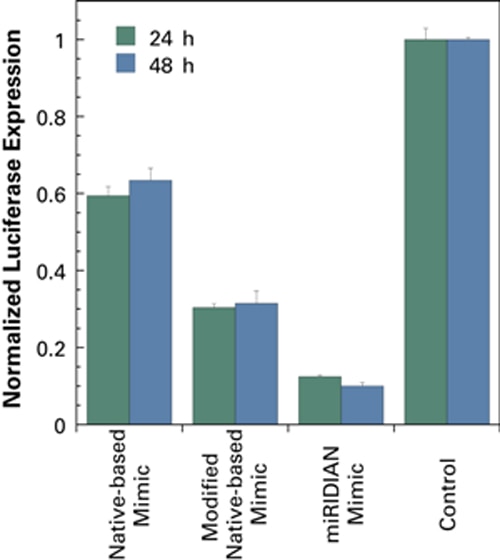- 遺伝子発現調節試薬
- RNA干渉
- microRNA (miRNA)
- miRIDIAN microRNA Mimic
miRIDIAN microRNA Mimic
Up-regulate endogenous microRNA activity for functional enhancement studies

miRIDIAN microRNA Mimic
1Start Here
2Choose
miRIDIAN microRNA Mimics are double-stranded RNA oligonucleotides designed to mimic the function of endogenous, mature microRNAs. miRIDIAN Mimics are chemically enhanced with the ON-TARGET modification pattern to preferrentially program RISC with the active microRNA strand. Predesigned mimics are available for all human, mouse, and rat microRNAs in the miRBase Database release 21.0.
Highlights
- Superior performance in comparison to native, double-stranded microRNA (see Figure 1, Supporting Data)
- Highly effective mimic of endogenous mature microRNA function (see Figure 2, Supporting Data)
- Preferential programming of RISC with active strand of microRNA
- Exclusion of passenger strand through proprietary chemical modification pattern
Applications
- Supplement microRNA activity to study functional enhancement effects
- Screen for microRNAs that regulate gene expression and affect cellular pathways
- Elucidate microRNA involvement in normal biological and disease pathways
- Identify and validate microRNA targets
A complete portfolio of positive and negative experimental controls to optimize conditions and design relevant microRNA modulation experiments. Critical to any successful microRNA modulation experiment, the right controls enable accurate interpretation for reliable results. Fluorescently labeled controls are also available for visual tracking.
Choose from our collection of validated positive and negative miRIDIAN Mimic controls for use in human, mouse or rat.
| miRIDIAN microRNA Mimic Positive Controls | Species | Catalog Number |
|---|---|---|
| miRIDIAN microRNA Mimic Housekeeping Positive Control #1 (PPIB) | Human | CP-001000-01 |
| Mouse | CP-002000-01 | |
| Rat | CP-003000-01 | |
| miRIDIAN microRNA Mimic Housekeeping Positive Control #2 (GAPD) | Human | CP-001000-02 |
| Mouse | CP-002000-02 | |
| Rat | CP-003000-02 | |
| miRIDIAN microRNA Mimic Endogenous Positive Control | Human, Mouse, Rat | CP-004000-01 |
| miRIDIAN Mimic Negative Control Reagents | Species | Catalog Number |
| miRIDIAN microRNA Mimic Negative Control #1 | Human, Mouse, Rat | CN-001000-01 |
| mIRIDIAN microRNA Mimic Negative Control #2 | Human, Mouse, Rat | CN-002000-01 |
| miRIDIAN Mimic Transfection Control Reagents | Species | Catalog Number |
| miRIDIAN microRNA Mimic Transfection Control with Cy3 | Human, Mouse, Rat | CP-004500-01 |
miRIDIAN microRNA Mimics perform better than native double-stranded microRNA

Figure 1. | miRNA mimic function was assayed in HeLa cells 24 and 48 hours after transfection of 10 nM miR-375 native double-stranded mimic, native double-stranded mimic with modifications, or the miRIDIAN microRNA Mimic using a dual luciferase reporter system and normalized to the control (no mimic).
miRIDIAN microRNA Mimics simulate endogenous mature miRNA function

miRIDIAN microRNA Mimicsは内在性の成熟miRNA機能をシミュレートする
Figure 2. | miRIDIAN microRNA Mimic function for 11 human miRNAs was assayed in HeLa and HepG2 cells 48 hours after transfection of 10 nM mimic using a dual luciferase reporter system and normalized to the control (no mimic treatment). Similar results were obtained with 1 nM miRIDIAN microRNA Mimic (results not shown).
Application notes
-
microRNA Mimic and Inhibitor Functional Analysis - Application Note
-
microRNA Targets in Stem Cell Differentiation - Application Note
-
Modulating endogenous miRNA targets with miRIDIAN microRNA mimics and inhibitors - Application Note
-
Screening microRNAs for Determinants of Osteogenesis - Application Note
Protocols
Safety data sheets
Selection guides
Related Products
The miRIDIAN microRNA Mimic Library is a complete collection of microRNA mimics arrayed in 96- or 384-well plates to allow high-throughput phenotypic screening applications in human, mouse, or rat.
The miRIDIAN microRNA Mimic Housekeeping Positive Controls allow for the direct monitoring of housekeeping genes in a microRNA mimic experiment. Positive Control #1 targets PPIB (aka Cyclophilin B).
The miRIDIAN microRNA Mimic Housekeeping Positive Controls allows for direct monitoring of housekeeping genes in a microRNA mimic experiment. Positive Control #2 targets GAPD so experimental conditions may be optimized with a validated mimic control.
The miRIDIAN microRNA Mimic Endogenous Positive Control helps you monitor specific mimic effects on target protein levels in a validated endogenous assay, which is based upon the targeted activity of miR-122 on Aldolase A mRNA levels in cell lines.
